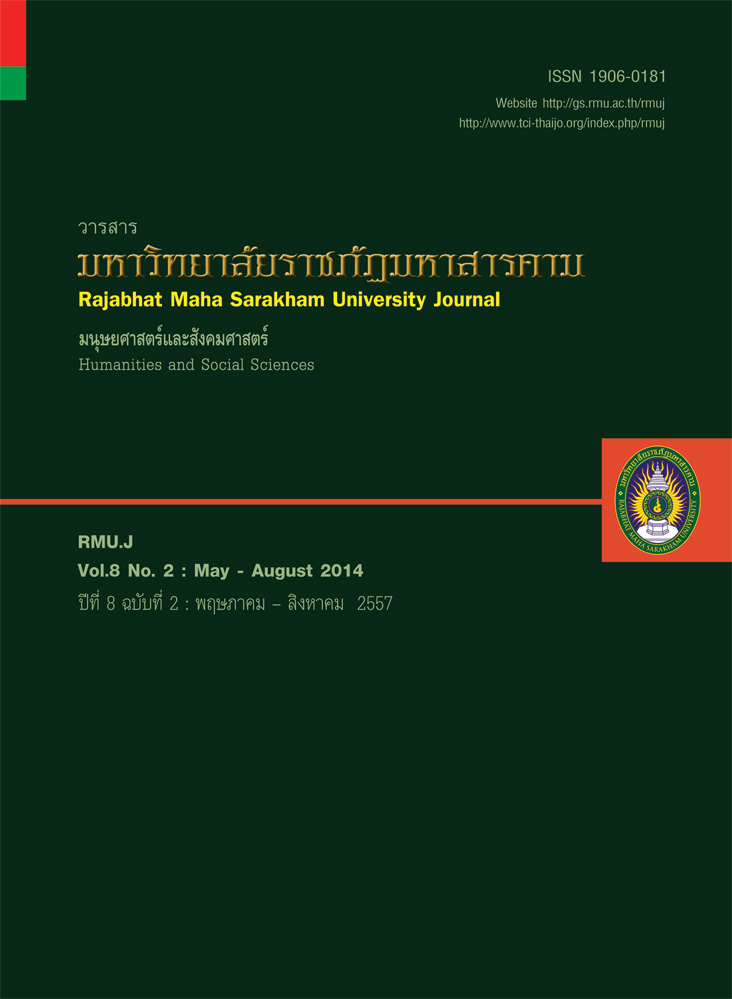กระบวนการวิจัยแบบมีส่วนร่วมเพื่อการพัฒนารูปแบบการบริหารจัดการเศรษฐกิจ การท่องเที่ยวแบบยั่งยืนของจังหวัดมหาสารคาม โดยระบบห่วงโซ่อุปทาน A Process of Participatory Research for the Development of Management Model for Sustainable Tourism Economics Using Suppl
Main Article Content
บทคัดย่อ
การวิจัยในครั้งนี้ผู้วิจัยมีวัตถุประสงค์ ประการแรก เพื่อวิเคราะห์ผลกระทบเศรษฐกิจการท่องเที่ยว และแนวโน้มการพัฒนา
เศรษฐกิจการท่องเที่ยว จังหวัดมหาสารคาม โดยส่งเสริมให้ชุมชนท้องถิ่นมีส่วนร่วม ประการที่สอง ศึกษาประเด็นที่มีผลต่อการบริหาร
จัดการเศรษฐกิจการท่องเที่ยว และประการที่สาม ศึกษาการพัฒนารูปแบบการบริหารจัดการเศรษฐกิจการท่องเที่ยวแบบยั่งยืนจังหวัด
มหาสารคาม โดยระบบห่วงโซ่อุปทาน ประชากรเป้าหมายที่ใช้คือชุมชนท้องถิ่นซึ่งเป็นผู้ที่เกี่ยวข้องกับเศรษฐกิจการท่องเที่ยวของแหล่ง
ท่องเที่ยว จังหวัดมหาสารคาม ประกอบด้วย พระธาตุนาดูน กู่สันตรัตน์ วนอุทยานโกสัมพี และอ่างเก็บนํ้าห้วยค้อ (พัทยานาเชือก)
ตลอดจนเขตห้ามล่าป่าดูนลำพัน โดยรวบรวมข้อมูลจากบุคลากรที่รับผิดชอบจากหน่วยงานทั้งภาครัฐ ภาคธุรกิจเอกชน จำนวน 6 คน
ตัวแทนประชาชนในแหล่งท่องเที่ยว จำนวน 10 คน และพันธมิตรทางการค้า จำนวน 19 คน ด้วยการใช้วิธีการดำเนินการวิจัยเชิง
คุณภาพ ซึ่งข้อมูลที่ใช้ในการวิจัย ประกอบด้วยข้อมูลทุติยภูมิซึ่งรวบรวมโดยศึกษาค้นคว้าและวิเคราะห์จากเอกสาร ตำรา บทความ
งานวิจัยที่เกี่ยวข้อง และสื่ออีเล็กทรอนิกส์ที่เกี่ยวข้องกับพื้นที่ที่สามารถเชื่อมโยงเศรษฐกิจการท่องเที่ยวในพื้นที่เป้าหมายกับข้อมูลปฐม
ภูมิโดยศึกษาเชิงสำรวจพื้นที่ การสังเกตและการสัมภาษณ์เจาะลึกแบบมีโครงสร้างทั้งที่เป็นทางการและไม่เป็นทางการ จากนั้นนำข้อมูล
มาสร้างข้อสรุปและวิเคราะห์แบบอุปนัย แล้วนำเสนอผลการวิเคราะห์ในเชิงพรรณนาความ เพื่อเชื่อมโยงประเด็นต่าง ๆ ในบริบทที่
เกี่ยวข้องกันในแต่ละประเด็นตามวัตถุประสงค์ ผลการวิจัยพบว่า
บุคลากรที่รับผิดชอบจากหน่วยงานภาครัฐและภาคธุรกิจเอกชน ได้ให้ข้อคิดเห็นเกี่ยวกับผลกระทบเศรษฐกิจการท่องเที่ยว
ภายนอกไว้ว่า แหล่งท่องเที่ยวทั้ง 5 แห่ง ของจังหวัดมหาสารคาม ส่วนใหญ่ยังขาดงบประมาณที่เป็นของตนเองในการพัฒนาธุรกิจการ
ท่องเที่ยวให้เป็นแหล่งชุมชนที่มีความเจริญและความเป็นอยู่ที่ดีขึ้น ที่สำคัญยังไม่มีการสร้างเครือข่ายการท่องเที่ยวกับสถานที่ท่องเที่ยว
อื่นในจังหวัดหรือในจังหวัดใกล้เคียง อาจเป็นเพราะไม่มีการวางแผนพัฒนาการท่องเที่ยว ส่งผลให้ไม่สามารถที่จะวางมาตรการกำกับ
ดูแล และตรวจสอบการท่องเที่ยวอย่างมีแบบแผนได้ ส่วนผลกระทบภายใน พบว่า แหล่งท่องเที่ยวแต่ละแห่งไม่สามารถที่จะดำเนินการ
เพือ่ ใหส้ อดรบั กับความตอ้ งการของนกั ทอ่ งเที่ยวไดอ้ ยา่ งตรงใจ ทั้งในเรื่องของสถานบรกิ ารและสิง่ อำนวยความสะดวกตา่ งๆที่ยงั ไมม่ าก
พอต่อการรองรับ โดยเฉพาะโรงแรมที่มีมาตรฐานและสิ่งอำนวยความสะดวกเพื่อรองรับภายในโรงแรม สำหรับแนวโน้มการพัฒนา
เศรษฐกิจการท่องเที่ยวพบว่าหน่วยงานที่เกี่ยวข้องกับแหล่งท่องเที่ยวได้เข้ามามีส่วนร่วมในการส่งเสริมการท่องเที่ยวอย่างเป็นรูปธรรม
น้อยเกินควร ซึ่งพิจารณาได้จากการส่งเสริมให้ชุมชนท้องถิ่นมีความรู้ร่วมกันเกี่ยวกับเศรษฐกิจการท่องเที่ยว การประชาสัมพันธ์เพื่อ
สร้างความเข้าใจในการพัฒนาเครือข่ายการท่องเที่ยว และการจัดหาและพัฒนาให้มีบุคลากรด้านการส่งเสริมการตลาดท่องเที่ยว รวม
ถึงการปรับปรุงพัฒนาแหล่งท่องเที่ยวให้มีจุดขายที่มีความเป็นอัตลักษณ์ซึ่งสามารถสร้างความสนใจให้แก่นักท่องเที่ยวได้ ทำให้
อุตสาหกรรมท่องเที่ยวขาดระบบการหมุนเวียนอย่างต่อเนื่อง ในที่สุดย่อมส่งผลกระทบให้ชุมชนท้องถิ่นในพื้นที่ที่เกี่ยวข้องต้องประสบ กับการขาดสภาพคล่องในการบริหารจัดการมากพอสมควร
ตัวแทนประชาชนซึ่งเป็นผู้ที่เกี่ยวข้องกับแหล่งท่องเที่ยวของจังหวัดมหาสารคาม ทั้ง 5 แห่ง ได้ให้ข้อคิดเห็นเกี่ยวกับประเด็นที่มีผล
ต่อการบริหารจัดการเศรษฐกิจการท่องเที่ยวแบบยั่งยืนไว้ว่า ในภาพรวมการที่จะบริหารจัดการเศรษฐกิจการท่องเที่ยวทั้ง 5 แห่ง ให้สามารถ
ดำเนินต่อไปได้อย่างเป็นระบบนั้นขึ้นอยู่กับประเด็นต่างๆ ที่มีความสัมพันธ์เกี่ยวข้องกับผลการเปลี่ยนแปลงที่เกิดจากการมีส่วนร่วมของ
ชุมชนท้องถิ่น ศักยภาพและแนวทางการพัฒนาการท่องเที่ยว และหลักการจัดการท่องเที่ยวแบบยั่งยืน เมื่อทำการวิเคราะห์แต่ละประเด็น
ลึกลงไป พบว่า ประเด็นต่างๆ เหล่านั้นต่างก็มีด้านที่เข้ามาเกี่ยวข้องแตกต่างกันออกไป ดังนี้ ประเด็นผลการเปลี่ยนแปลงที่เกิดจากการมี
ส่วนร่วมของชุมชนท้องถิ่น ประกอบด้วยประเด็นย่อย 2 ด้าน ได้แก่ ความต่อเนื่องของกิจกรรมการท่องเที่ยว และการกระจายผลประโยชน์
ประเด็นศักยภาพและแนวทางการพัฒนาการท่องเที่ยว ประกอบด้วยประเด็นย่อย 3 ด้าน ได้แก่ การส่งเสริมการตลาดและการนำเที่ยว การ
พัฒนาโครงสร้างพื้นฐานและการบริการ และการส่งเสริมการลงทุน และประเด็นหลักการจัดการท่องเที่ยวแบบยั่งยืน ประกอบด้วยประเด็น
ย่อย 3 ด้าน ได้แก่ ประสานแผนการพัฒนาการท่องเที่ยว การสนับสนุนเศรษฐกิจท้องถิ่น และการฝึกอบรมบุคลากร
พันธมิตรทางการค้าซึ่งเป็นผู้ที่เกี่ยวข้องกับเศรษฐกิจการท่องเที่ยวของแหล่งท่องเที่ยวทั้ง 5 แห่ง ต่างให้ข้อคิดเห็นไว้ว่า
การพัฒนารูปแบบการบริหารจัดการเศรษฐกิจการท่องเที่ยวแบบยั่งยืน จังหวัดมหาสารคาม ด้วยระบบห่วงโซ่อุปทานนั้น ควรพัฒนา
ประเด็นหลัก ๆ 5 ด้าน ได้แก่ การปรับปรุงโครงสร้างพื้นฐานและสิ่งอำนวยความสะดวก การปรับราคาท่อง เที่ยวของบริษัทนำเที่ยว
และผู้ประกอบการ และการปรับวิธีการและยกระดับการให้บริการ ตลอดจนการปรับกลยุทธ์การ ตลาดท่องเที่ยว รวมทั้งการพัฒนา
ทรัพยากรการท่องเที่ยวและสิ่งแวดล้อมในแหล่งท่องเที่ยว ซึ่งในการที่จะทำให้แหล่งท่อง เที่ยวสามารถที่จะลดต้นทุนในการดำเนินงาน
ได้นั้น ชุมชนท้องถิ่นจำเป็นที่จะต้องปรับปรุงและพัฒนาปัจจัยพื้นฐาน ปรับและพัฒนาบุคลากรการท่องเที่ยว ปรับราคาธุรกิจการท่อง
เที่ยว และพัฒนาขีดความสามารถในการประสานงานกับธุรกิจอื่นที่เกี่ยวข้อง ส่วนการที่จะทำให้แหล่งท่องเที่ยวสามารถที่จะเพิ่มคุณภาพ
การบริการได้นั้นจำเป็นที่จะต้องมีการสร้างมาตร ฐานการจัดและบริการเพื่อรองรับนักท่องเที่ยว ปรับกลยุทธ์การตลาดท่องเที่ยว รักษา
ความปลอดภัยในชีวิตและทรัพย์สิน และพัฒนาระบบการกระจายข้อมูลข่าวสารการท่องเที่ยว
The purposes of this research were to: 1) analyze the impacts of tourism economics, and trends of
tourism economics development in Maha Sarakham province by local community participation; 2) study the
issues affecting tourism economics management ; and 3) study the development of management model for
sustainable tourism economics using supply chain in Maha Sarakham province.
The target groups were local community people who have involved in tourism economics of tourist
attractions in Maha Sarakham province, including Phra That Na Dun, Ku Santarat, Kosamphi Forest Park, and
Pattaya Na Chueak Reservoir and Dun Lamphan No-hunting Area. The data were collected qualitatively from
6 personnel from both government and private business sectors, 10 representatives of the people in tourist
attractions, and 19 persons in commercial alliance. The collected data comprised both primary and secondary
data. The secondary data were collected and analysed through documents, textbooks, articles, research and
electronic media related to the areas that were able to link with tourism economics in the target ones. The
primary data were collected through field surveys, observation, and formal and informal in-depth structured
interviews. The collected data were concluded and analyzed inductively and were presented in descriptive
manner to link various issues in the context related to the research purposes.The findings were concluded as follows:
The personnel from both government and private business sectors opined external impacts of tourism
economics were as follows: the majority tourist attractions in Maha Sarakham province had insufficient own
budget for the development of tourism business to be civilization and standards; there were no building of
tourism networks with other tourist attractions in the province or in the nearby provinces because of no tourism
development plans which resulted in being unable to control, supervise, and check tourism system orderly.
The internal impacts of tourism economics showed that each tourist attraction was unable to serve the needs
of the tourists in terms of hotel services and facilities that were insufficient, especially standard hotels with full
facilities. The trends of tourism economics development revealed that few agencies associated with tourist
attractions got involved in tourism promotion to make local community gain knowledge about tourism economics,
ran public relations for a better understanding of tourism networks development, and sought personnel for
tourism promotion as well as improved tourist attractions to have their own identity that aroused the tourists’
interests. These resulted in tourism industry with no continuous flow system and then caused local community
in related areas to lackt active management.
The representatives of people who live in 5 tourist attractions in Maha Sarakham province commented
on the issues affecting sustainable tourism economics management in that tourism economics management,
as a whole, can be operated systematically depending on the 3 different issues relating to the changes effects
of the participation of local communities, the potential of and guidelines for tourism development, and principles
of sustainable tourism management. When each issue was analyzed deeply, it was found that the changes
effects of the participation of local communities consisted of 2 sub aspects as continuation of tourism activities
and the distribution of benefits ; the potential of and guidelines for tourism development consisted of 3 sub
aspects as marketing promotion, infrastructure and service development, and investment promotion; and
principles of sustainable tourism management consisted of 3 aspects as joining tourism development plan,
supporting local economics, and training staffs.
The representatives of commercial alliance who involved tourism economics of 5 tourist attractions in
Maha Sarakham province commented on management model development for sustainable tourism economics
using supply chain in that 5 main aspects should be improved. They included the improvement of infrastructure
and facilities; the adjustment of tourism prices of travel agencies and entrepreneur; and the adjustment of service
procedures and levels of service, the adjustment of tourism marketing strategies, and the development of tourism
resources and environment in tourist attractions. To reduce the cost of management of tourist attractions, local
communities needed to improve basic requisites, develop tourism personnel, adjust prices of tourism business,
and improve their own capacity to co-work with other related business. To increase the quality of services in
tourist attractions, building up the service standards for tourists; adjusting tourism marketing strategies, protecting
life and property in security, and developing tourism information distribution system needed to be done.
Article Details
1. บทความที่ลงตีพิมพ์ทุกเรื่องได้รับการตรวจทางวิชาการโดยผู้ประเมินอิสระ ผู้ทรงคุณวุฒิ (Peer Review) สาขาที่เกี่ยวข้อง อย่างน้อย 3 ท่าน ในรูปแบบ Double blind review
2. ข้อคิดเห็นใด ๆ ของบทความที่ลงตีพิมพ์ในวารสารมหาวิทยาลัยราชภัฏมหาสารคาม นี้เป็นของผู้เขียน คณะผู้จัดทำวารสารไม่จำเป็นต้องเห็นด้วย
3. กองบรรณาธิการวารสารมหาวิทยาลัยราชภัฏมหาสารคาม ไม่สงวนสิทธิ์การคัดลอกแต่ให้อ้างอิงแสดงที่มา


